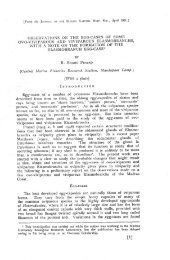PDF - Eprints@CMFRI
PDF - Eprints@CMFRI
PDF - Eprints@CMFRI
Create successful ePaper yourself
Turn your PDF publications into a flip-book with our unique Google optimized e-Paper software.
86<br />
Also the extension of the axial fossa to either ends of the corallum inH. simplex, as GARDINER (1905)<br />
assumes, is no specific character. There are specimens with shorter fossa and, on the other hand, specimens<br />
of F. ecbinata with long extending grooves.<br />
BOSCHMA (192 5) supposes that H. simplex has smaller costal spines and stronger granulated septa of<br />
heigher orders than F. ecbinata. After VERON & PICHO (1980) the tWO forms differ in the following<br />
way: "Adult H. simplex are always polycentric, have more numerous, less alternating septa with triangular<br />
rather than lobate tentations with a thickened axial rod , and more numerous costal spines." We believe<br />
that all these differences are lying within the skeletal variability.<br />
Therefore we propose to put together the two forms and to raise the subgenus Ctenactis again into<br />
the rank of a genus, as already recommended by VERR ILL (1864).<br />
MadrepON<br />
Halig/oull<br />
Cuna"is<br />
Halig/ossa<br />
Fungio<br />
Htrpelo/irbas<br />
Fungia<br />
HaUg/ossa<br />
HerpetoJitbas<br />
Htrpo/itba<br />
HerpeloglosSQ<br />
ecbinata<br />
ecbinala<br />
ecbinalQ<br />
ecbinala<br />
ecbiruull<br />
ebrenbergi;<br />
ehrenberg;<br />
pectinata<br />
rueppellii<br />
simplex<br />
simplex<br />
Ctenactis ecbinata (PALLAS), 1766<br />
(Plate 20, Figs. 6- 9)<br />
1766. PALLAS. 284 (Type locality: Indian Ocean).<br />
1834, EHRENBERG. 274 (No. 780 in Mu~um Berlin).<br />
1864 . VERRILL, SI.<br />
1879, KLUNZINGER 3,67.<br />
1902, DOEDERLEIN. lOl ;pi. 10/ 1- $ (synonymy>,<br />
1906, v. MARENZELLER, 63.<br />
1954, ROSSI,41.<br />
1967. SCHEER, 428.<br />
1971 . LOVA & SLOBODKIN. 123.<br />
1974. SCHEER & PILLAI. 37 (synonymy).<br />
1976. PI LLAI & SCHEER, 43.<br />
1979. SCHUHMACHER, 210.<br />
1980. VERON & PICHON, 169; figs. 283-289.<br />
1980. HEA D, 150.453.<br />
1841 , LEUCKART, 52; pI. 2/1 - 3.<br />
1860. MILNE EDWARDS ( & HAIME), 14.<br />
1889. ORTt\1ANN. 521.<br />
1879. KLUNZINGER 3,66.<br />
1841, LEUCKART. 54 ; pI. 111 - 3.<br />
1905, GARDINER, 943 ; pI. 91113.<br />
1925, BOSCH~IA . 223 ; pI. 7/68- 70.<br />
1955. NEMENZO, 76; pI. 14/2.4.<br />
1966, WELLS , 241.<br />
1980, VERON & PICHON, 173 ; figs. 290- 293.<br />
There are 24 specimens of this species in the present collections. All pieces have an elongate shape<br />
with an axial furrow extending more or less over the entire length of the corallum. The largest specimen<br />
before us is 28 cm long. In one of the specimens (Rtvl 72) the corallum is four-lobed. The axial fossa<br />
extends to all the four arms.<br />
After the combination of Fungia ecbinata and Herpetoglossa simplex the present species is easily to<br />
identify by virtue of the characteristic form, the septal dentation and the costal spines. The axial furrow<br />
can be monocenrric or polycentric by fusion of opposite septa.<br />
Material :<br />
Gulf of Aqaba :<br />
orthern R. S.:<br />
Central R. S.:<br />
Southern R. .:<br />
Jerus.<br />
T . Aviv<br />
T. Aviv<br />
HLM<br />
P. Sud.<br />
HLM<br />
HLM<br />
SLR<br />
NS<br />
S<br />
X2:<br />
EC<br />
Sa<br />
RM<br />
X2 :<br />
EC<br />
395 - 2,3,4,5 , 7, 1275 (Marsa Murach).<br />
230, 9290 (Eilat); 1883 (Dahab).<br />
1868 (Ras Muhammad).<br />
3-38 (Guballsl.)<br />
473 (Ras Abu Suma); 62 (Koseir, duplicate from KLUNZINGER );<br />
296 (Ras Abu Hagar).<br />
12 (Sanganeb R. ).<br />
14, 17 , 17a, 72 (Wingate R.).<br />
10- 5, 10- 13 (Sarso 151.).<br />
365 , 366 , 367 (Mas5awa).
















